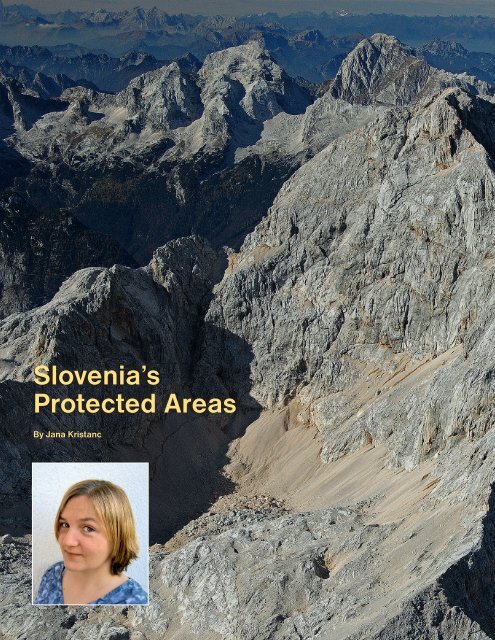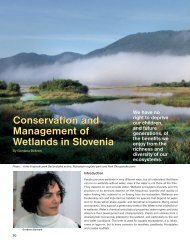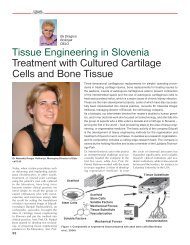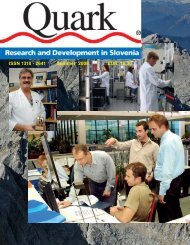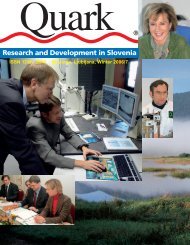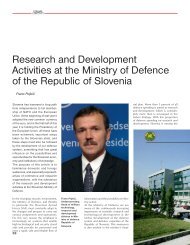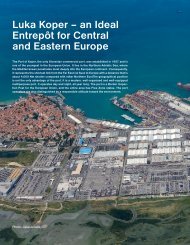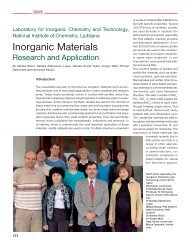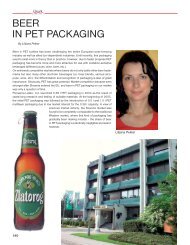Slovenia's Protected Areas Slovenia's Protected ... - Quark Magazine
Slovenia's Protected Areas Slovenia's Protected ... - Quark Magazine
Slovenia's Protected Areas Slovenia's Protected ... - Quark Magazine
You also want an ePaper? Increase the reach of your titles
YUMPU automatically turns print PDFs into web optimized ePapers that Google loves.
Slovenia’s<br />
<strong>Protected</strong> <strong>Areas</strong><br />
By Jana Kristanc<br />
70
Photo: Matevž Lenarčič<br />
Triglav National Park<br />
• “where eternal beauty takes one’s breath away...”;<br />
• named after Mount Triglav, the country’s highest mountain<br />
and a symbol of Slovenia;<br />
• a typical Alpine national park with the highest peaks in the<br />
Slovenian section of the Julian Alps, deeply incised valleys,<br />
vertical rock faces, inaccessible ravines, rushing water,<br />
mixed forest, carpets of Alpine flowers and characteristics<br />
of high-mountain karst;<br />
• the European watershed between the Mediterranean and<br />
the Black Sea;<br />
• the border between two building cultures: of stone and of<br />
wood;<br />
• the country of the emerald river Soča, home to the endemic<br />
and threatened marble trout (Salmo marmoratus);<br />
• the first UNESCO-MAB area in Slovenia;<br />
• awarded the Council of European Diploma of <strong>Protected</strong><br />
<strong>Areas</strong> in 2004.<br />
Triglav National Park has national importance for Slovenians<br />
while at the same forming part of the country’s international<br />
profile. A variety of activities are constantly taking place in the<br />
park and attracting large numbers of visitors. The park also<br />
collaborates with other national parks around Europe and is<br />
preparing a number of new features and projects. For example,<br />
visitors can set off on cycling excursions along various<br />
routes or learn something new on the Barje Goreljek nature<br />
trail, where they can see how peat bogs form and encounter<br />
interesting organisms such as carnivorous plants.<br />
The park tries to connect nature protection, agriculture and<br />
tourism. This last is an important sector: in recent years, the<br />
park has received between 2 million and 2.5 million visitors<br />
annually. Professional guides are available for themed routes<br />
and the high mountain area.<br />
The park covers an area of 83,807 hectares. It contains 25<br />
settlements and hamlets with a total of 2,200 inhabitants.<br />
More information is available at www.tnp.si<br />
71
Biodiversity is part<br />
of Slovenia’s wealth<br />
Biological diversity is a precious<br />
resource that is still much undervalued.<br />
It has formed over the course<br />
of millions of years through evolution<br />
and includes all forms of life, from<br />
the smallest microbes to the largest<br />
plants and animals, our habitats and<br />
ecosystems from forests, deserts<br />
and wetlands to agricultural land<br />
and city parks, and also the reciprocal<br />
influences among different living<br />
creatures and their connections<br />
with the environment. This mosaic<br />
of myriad factors that took so long<br />
to be created is in itself very fragile,<br />
vulnerable and exposed to human<br />
influences.<br />
Thanks to biodiversity, we can provide<br />
ourselves with various goods<br />
and enjoy benefits such as food,<br />
energy, materials, products that protect<br />
our health, alongside ecological<br />
services that are provided by the<br />
balance of natural process, such as<br />
fertile soil, clean water and air, and<br />
the regulation of the climate.<br />
The conservation of biodiversity in<br />
Slovenia is linked to the extraordinary<br />
variety of ecosystems and landscape<br />
models in a relatively small area measuring<br />
20,254 km2. Its main characteristics<br />
are:<br />
• the interweaving of the biogeographical<br />
regions of the Alps (30%),<br />
the Dinaric range (30%), the Pannonian<br />
Plain (30%) and the Mediterranean<br />
(10%) as a reflection of<br />
the interweaving of geological and<br />
climate factors;<br />
• variety in climate, geological basis<br />
and soil types, and hydrography<br />
and hydrology, as the basis of an<br />
extraordinary variety of ecosystems;<br />
• about 22,000 plant and animal<br />
species recorded, with total estimates<br />
ranging between 50,000 and<br />
120,000 (which proves the very<br />
great variety in a small area) including<br />
endemic and threatened species,<br />
which are especially important<br />
from the point of view of maintain-<br />
72<br />
Photo: Matevž Lenarčič<br />
ing biodiversity, and which, taking<br />
into account Slovenia’s geographical<br />
position, occupy a relatively<br />
high share of the total;<br />
• the Karst, which covers<br />
approximately 44% of the national<br />
territory and is characterised by great<br />
diversity and endemism of species,<br />
and in particular by a relatively high<br />
number of subterranean animals in
The importance of parks in Slovenia<br />
Janez Podobnik<br />
Preserved nature is part of the fundamental identity of a country and its<br />
population. It is a thing of value in itself, and involves such important components<br />
of the territory, and of our national and regional identity, that it is<br />
practically priceless. At the same time, it can also be an important resource<br />
of considerable economic importance.<br />
Our opportunities for development depend in part on how sustainably we<br />
are capable of managing our valuable natural features. Proof that we are<br />
capable of this is provided by our sustainable management of forests,<br />
which in terms of extent and function are one of Slovenia’s most valuable<br />
resources.<br />
The production of high-quality food is a very important development opportunity<br />
offering possibilities for the development of modern agriculture and an<br />
opportunity for the successful marketing of healthy food grown in Slovenia.<br />
Parks can help in this, in the development of brands and in providing a recognisable<br />
geographical origin.<br />
The greatest economic effect of protected areas cited in literature and in<br />
examples of good practice from other European countries is tourism. A<br />
diverse natural environment attracts ever more demanding visitors and is<br />
therefore an important stimulus to the development of tourism. Tourism and<br />
catering in Slovenia generate 9% of GDP and employ approximately 52,000<br />
people. Natural beauty is a key element of tourism in Slovenia and an important<br />
point of contact between economic development, nature conservation<br />
and environmental protection. More than 30% of foreign tourists come to<br />
Slovenia above all because of its natural beauty, 30% of Slovenes spend<br />
their free time in natural spaces, and the number of nature-lovers in Europe<br />
is growing all the time.<br />
Visits to certain natural sights prolong the tourist season, and, thanks to<br />
longer stays by foreign visitors, the circle of activities enjoying the benefits of<br />
sustainable development is widening. <strong>Protected</strong> areas offer the opportunity<br />
for conserved nature to become an internationally recognised advantage of<br />
Slovenia. It is estimated that the protection of biodiversity indirectly generates<br />
four to six times as many jobs as it generates directly. Even property<br />
prices are usually higher in protected areas.<br />
However, protected areas are only a development advantage if they are<br />
recognised as such, and if development potentials are suitably exploited in<br />
the context of development based on the principles of sustainability. The<br />
principal operators in sustainable development are the inhabitants of protected<br />
areas.<br />
The full exploitation of the development potential of protected areas<br />
requires, alongside nature protection, a key role to be played by regional<br />
policy, spatial planning policy and economic policy, and also by other sectors.<br />
The main task of the state should thus not be weighing up the advantages<br />
and costs of protecting these areas, but measures to encourage<br />
development opportunities and the training of interested parties for their<br />
sustainable exploitation.<br />
The advantage for the local population of a development policy co-ordinated<br />
in this way lies, above all, in the pooling of resources from a system of differ-<br />
Ministry of the Environment and Spatial Planning<br />
Janez Podobnik, Minister of the Environment<br />
and Spatial Planning<br />
ent types of support. The European Union channels many development programmes towards park areas in the form<br />
of regional development, support for local communities, agri-environmental programmes, tourism, training the local<br />
population for self-employment, nature protection, conservation of cultural heritage, etc.<br />
Parks today are not only active in the sphere of nature protection, they also look after cultural heritage, implement<br />
development projects, provide unique opportunities for tourism, educate, and support international promotion of<br />
Slovenia.<br />
73
comparison with other karst areas<br />
around the world;<br />
• agricultural land covers 33% of<br />
the territory and includes a whole<br />
range of extensively exploited<br />
agrarian ecosystems important for<br />
maintaining numerous threatened<br />
species and their habitats;<br />
• freshwater and coastal wetlands,<br />
which cover only a small percentage<br />
(less than 1%) of the territory<br />
but which are extremely important for<br />
maintaining biodiversity;<br />
• the mountainous nature of the territory<br />
with high biodiversity value;<br />
• particularly notable is the high level<br />
of forestation – forests cover 62%<br />
of the territory and relatively large<br />
and self-contained forest ecosystems,<br />
which are also extensively<br />
exploited, are the habitat of vital<br />
populations of large mammals<br />
threatened at European level.<br />
However, this richness is threatened:<br />
research points to an accelerating fall<br />
in the number of plant and animal<br />
species in Slovenia. Of the 3,200<br />
74<br />
known species of pteridophytes and<br />
spermatophytes, 330 are on the World<br />
Conservation Union (IUCN) Red List of<br />
threatened species. Of the 423 known<br />
vertebrates in Slovenia, 238 are threatened.<br />
Species are threatened above all<br />
because of:<br />
• fragmentation of ecosystems and<br />
habitats;<br />
• degradation and destruction of the<br />
habitats of plant and animal species;<br />
• disturbance of animal species in<br />
their natural environment at times<br />
of the year that are key for their<br />
survival;<br />
• genetic “erosion” and merging of<br />
species.<br />
For some decades now, the world has<br />
been seeing a strong downward trend<br />
in biodiversity (around 50,000 plant<br />
and animal species are estimated to<br />
disappear from the face of the Earth<br />
forever each year). Existing measures<br />
to reduce the problem of the loss of<br />
biodiversity have long ceased to be<br />
sufficient to reverse current trends, and<br />
Photo: Matevž Lenarčič
therefore an integrated and<br />
internationally co-ordinated<br />
approach to the conservation<br />
and sustainable use of<br />
biodiversity has become<br />
urgently necessary. In 1992,<br />
more than a hundred countries,<br />
Slovenia among them,<br />
signed the Convention on<br />
Biological Diversity in Rio<br />
de Janeiro. The purpose<br />
of the Convention was to<br />
achieve sustainable development<br />
through realisation<br />
of the main objectives of<br />
the Convention, which are:<br />
• the conservation of biological<br />
and landscape<br />
Kolpa Landscape Park<br />
diversity at the national and local<br />
levels, and the sustainable use of<br />
their components,<br />
• the incorporation of the principles<br />
of conservation of biological diversity<br />
into all sectors and other levels<br />
of the state,<br />
• suitable inclusion of the public<br />
in the conservation of biological<br />
diversity and landscape variety,<br />
• fair and equitable sharing of the<br />
benefits from the use of biodiversity<br />
such as access to genetic resources,<br />
the transfer of relevant technology<br />
and sharing of revenue.<br />
Slovenia ratified the Convention in<br />
1996. By ratification, a State Party also<br />
• based around the Kolpa, one of the cleanest rivers in Slovenia, with a well conserved<br />
riverbed, gravel beds and rapids;<br />
• a gallery of biodiversity and landscape variety with beech woods, a characteristic<br />
fern, carefully tended fields and vineyards, cultivated terraces and dolines,<br />
old waterside willows, karst springs and thermophilous (heat-loving) plants on<br />
the steep rock walls;<br />
• a safe haven for otters within the Kolpa and its tributaries;<br />
• home of authentically conserved living traditions of various local crafts and a<br />
characteristic cultural tradition;<br />
• a park with the only strict nature reserve in Slovenia – Hrastova Loza: a stand of<br />
beeches with nesting sites of the grey heron (Ardea cinerea).<br />
Kolpa Landscape Park covers 43 km 2 and contains 28 settlements with a total of<br />
over 1,700 inhabitants. More information is available at www.kp-kolpa.si<br />
Ministry of the Environment and Spatial Planning<br />
Photo: Tomaž Učakar<br />
assumes responsibility for its implementation,<br />
which also includes the<br />
preparation of a national biodiversity<br />
conservation strategy including all<br />
sectors (forestry, agriculture, fisheries,<br />
power, transport, spatial planning) that<br />
through their activities have an impact<br />
on biodiversity.<br />
Conserved biodiversity guarantees a<br />
higher quality of life for the individual<br />
and offers resources for development<br />
for numerous activities. For this reason,<br />
conservation of biodiversity should be<br />
in the interest of the majority of people.<br />
Thus, conserved biodiversity is a development<br />
value, which facilitates, for<br />
example, the development of tourism.<br />
As a rule, the conservation of biodiversity<br />
and other activities seek common<br />
interests in protected areas/parks.<br />
The protection of an area is one of<br />
the most important and oldest in situ<br />
nature protection measures. <strong>Protected</strong><br />
areas create a basis for integrated<br />
nature conservation; they are at the<br />
same time the hubs of the ecological<br />
network and a fundamental element<br />
in the conservation of Slovenia’s great<br />
diversity of ecosystems and landscapes.<br />
In Slovenia, as elsewhere in the world,<br />
parks, as extensive ecosystemic<br />
wholes, are extremely important for<br />
the conservation of ecosystem variety<br />
and landscape diversity, while above all<br />
supporting sustainable management of<br />
natural goods, and thus becoming an<br />
increasing opportunity for the basic<br />
developmental interests of the local<br />
population.<br />
The history of parks in<br />
Slovenia<br />
Throughout the world, parks are created<br />
to protect biodiversity and the<br />
natural environment. In Europe, the<br />
first nine national parks were founded<br />
by Sweden in 1910. Slovenia became<br />
the fifth country in Europe to designate<br />
a national park when, in 1924, it<br />
protected the area around the Triglav<br />
Lakes.<br />
Since these beginnings, the number<br />
of protected areas in Europe has constantly<br />
increased, so that there are now<br />
just under 600 different categories and<br />
more than 42,000 protected areas in<br />
the Member States of the European<br />
Union.<br />
In Slovenia, the Nature Conservation<br />
Act divides protected areas into small<br />
and large areas and defines six catego-<br />
75
ies. Small protected areas are strict<br />
nature reserves, nature reserves and<br />
natural monuments; large protected<br />
areas, also known as parks, are national<br />
parks, regional parks and landscape<br />
parks. While small protected areas are<br />
mainly concerned with the implementation<br />
of nature protection measures,<br />
parks have a considerably broader<br />
Kozjansko Regional<br />
Park<br />
• at the point of transition between<br />
the stormy Alps and the placidity<br />
of the Pannonian Plain;<br />
• a landscape of characteristic<br />
hills on the southeastern edge<br />
of the Alpine world with a mosaic<br />
of fields, orchards, vineyards,<br />
flowering meadows, forests and<br />
hidden streams;<br />
• a land of many faces with many<br />
cultural monuments and ethnological<br />
peculiarities;<br />
• an ancient and historically rich<br />
area, known in antiquity as Polis<br />
norikon, with characteristic settlements<br />
atop apparently inaccessible<br />
hills;<br />
• contains the thickest oak (Quercus<br />
robur) in Slovenia with a trunk<br />
diameter of 8 metres;<br />
76<br />
• includes sub-Alpine mountains,<br />
hill vineyards, the<br />
plains along the river Sotla<br />
and varied natural features<br />
with a rich cultural heritage<br />
The park contains the<br />
Rudnica geological trail and<br />
numerous other footpaths<br />
and wine routes. It also<br />
hosts the Kozjansko Apple<br />
Festival, an international<br />
event presenting organic<br />
farms. Podsreda Castle, a<br />
centre of cultural and social<br />
activity in the wider area, is a<br />
famous attraction.<br />
Kozjansko Regional Park<br />
receives around 35,000 visitors<br />
a year. It extends over an area<br />
of 206 km2, and contains 82<br />
settlements. More information is<br />
available at www.gov.si/kp
Goričko Landscape Park<br />
• “a pastoral symphony with echoes of the undulation of the Pannonian Sea”;<br />
• a trilateral cross-border park straddling three countries: Austria, Hungary and Slovenia;<br />
• a typical dry landscape with the most continental climate and lowest rainfall in Slovenia;<br />
• a splendour of biodiversity with an interweaving of mixed forests, willow groves, dry, wet and<br />
extensive meadows, wetlands, old orchards, vineyards, fields and mineral springs;<br />
• a landscape of old field crops: pumpkins, buckwheat, rice, spelt, sunflowers, wheat and<br />
barley;<br />
• a landscape with its own traditions;<br />
• one of the most important international areas of migration routes and wintering quarters for<br />
birds;<br />
• the area with the most important<br />
population of otters (Lutra lutra) in<br />
Slovenia.<br />
Goričko Landscape Park, in the<br />
northeast of the country, is a protected<br />
landscape park. It contains<br />
a mixture of cultivated and natural<br />
areas, popular with cyclists and<br />
ramblers. Goričko boasts many<br />
masters of traditional local crafts<br />
including thatching, Easter egg<br />
decorating, corn fibre crafts,<br />
pottery, blacksmithing and crochet-work.<br />
The park covers an area of 462<br />
km 2 and contains 90 villages with<br />
a total of 23,000 inhabitants. More<br />
information is available at www.parkgoricko.org<br />
77
ole, namely the conservation of the<br />
biological wealth of plants and animals<br />
and their ecosystems, and also the conservation<br />
of landscape diversity. Parks<br />
also take into account and facilitate<br />
development opportunities for the<br />
population, and spiritual relaxation and<br />
enrichment of people’s lives.<br />
The idea of the park in Slovenia thus<br />
follows the “Parks for Life” concept<br />
which was supported by the IUCN in<br />
1994. In this concept, parks become<br />
centres or models for the implementation<br />
of sustainable development, with<br />
an emphasis on the economic opportunities<br />
that such development offers,<br />
above all to the local population.<br />
<strong>Protected</strong> areas are one of the measures<br />
of nature protection. The Nature<br />
Protection Act defines the following<br />
types of protected areas:<br />
Large:<br />
• A national park is a large area with<br />
numerous valuable natural elements<br />
and high biodiversity. Nature<br />
in its original state, with conserved<br />
ecosystems and natural processes,<br />
is present in the greater part of<br />
the park, while a smaller part of<br />
a national park may also contain<br />
areas of greater human influence,<br />
which is however harmonious.<br />
• A regional park is an extensive<br />
area of regionally characteristic<br />
ecosystems and landscape with<br />
large areas of natural features in<br />
their original state and areas where<br />
such features interweave with areas<br />
where human influence is greater,<br />
although in balance with nature.<br />
• A landscape park is an area where<br />
the interaction of people and<br />
nature over time has produced an<br />
area of significant ecological, biological<br />
or landscape value.<br />
Small:<br />
• A strict nature reserve is an area<br />
of naturally conserved geotopes,<br />
habitats of threatened, rare or<br />
characteristic plant or animal species,<br />
or an area important for the<br />
conservation of biodiversity where<br />
natural processes take place largely<br />
without human influence.<br />
• A nature reserve is an area of<br />
geotopes, habitats of threatened,<br />
rare or characteristic plant or<br />
animal species, or an area important<br />
for the conservation of biodiversity<br />
which is also maintained<br />
through human activity in balance<br />
with nature.<br />
78<br />
Photo: Matevž Lenarčič<br />
Sečovlje Salina Nature Park<br />
• “where culture and a 700-year tradition have shaped an element of natural value, and where<br />
the air smells of salt, the energy of the sea enchanted in crystals”;<br />
• site of the northernmost traditional salt pans in the Mediterranean, home to 45 threatened<br />
Slovenian IUCN Red List plant species;<br />
• because of the traditional salt-making process, used here for 700 years, salt pans feature<br />
the “petola”, a living carpet cultivated by the saltworkers to prevent salt mixing with the soil, and<br />
where salt is collected every day;<br />
• due to the salt, an area of special ecological conditions in which only the most adaptable species<br />
live, including numerous halophytic (salt-tolerant) plants;<br />
• an internationally important migration area, nesting site and wintering ground for various species<br />
of birds;<br />
• a Ramsar Convention area.<br />
Sečovlje Salina Nature Park conserves the tradition of salt-making. Numerous autochthonous<br />
plant and animal species have found their home in it. Every year, the park hosts the Saltworkers’<br />
Festival, which illustrates key events in the process of making salt. Artistic events and presentations<br />
are also organised, in an effort to conserve the numerous species and habitats in the<br />
Šečovlje salt pans. The park contains a nature trail. At weekends guides accompany visitors<br />
along the trail free of charge. The cultural heritage of the saltworkers is presented at the Museum<br />
of Salt-Making.<br />
The park receives around 27,000 visitors a year and covers an area of 650 hectares – of which<br />
552 are covered by water and 98 are on dry land. There is no human habitation in the park. More<br />
information is available at www.kpss.soline.si
Photo: Matevž Lenarčič<br />
• A natural monument is an area<br />
containing one or more natural features<br />
that are outstanding in terms<br />
of form, size, content or position,<br />
or are a rare example of a natural<br />
feature.<br />
Slovenia currently has 1 national park,<br />
3 regional parks, 42 landscape parks, 1<br />
strict nature reserve, 52 nature reserves<br />
and 1185 natural monuments.<br />
The large protected areas – parks – currently<br />
cover 2,300 km 2 , which is more<br />
than 11% of the national territory.<br />
Development opportunities<br />
in parks<br />
The most naturally conserved areas of<br />
Slovenia are located in areas where,<br />
owing to natural conditions, develop-<br />
ment opportunities have been and still<br />
are limited, and where it is usually very<br />
difficult to envisage alternative development<br />
programmes.<br />
In view of the limited opportunities for<br />
development of these predominantly<br />
agricultural areas, parks are one of<br />
the models of regional development<br />
and a focus for resources while taking<br />
into account one of the few comparative<br />
advantages – nature and a unique<br />
landscape.<br />
Perhaps this is also because, for the<br />
most part, parks lie in areas where<br />
development opportunities are very<br />
small. There are few jobs and these<br />
areas suffer a significant “brain drain”<br />
and population exodus in general. It<br />
is precisely because of these specific<br />
characteristics that municipalities are<br />
taking noticing of the development<br />
opportunities in proclaiming an area as<br />
a park. There is also great potential in<br />
tourism, since many Slovenians enjoy<br />
relaxing in nature and a large number<br />
of foreigners visit Slovenia precisely<br />
because of its natural beauties.<br />
Parks are therefore active in the sphere<br />
of nature protection, while at the same<br />
time contributing to protection of<br />
cultural heritage, implementing development<br />
projects, providing unique<br />
opportunities for tourism, education,<br />
and supporting international promotion<br />
of Slovenia.<br />
Agriculture in parks<br />
Within the European Union, in the<br />
many places in these areas where natural<br />
conditions do not enable intensive<br />
agricultural production, the future of<br />
agriculture is only possible in connection<br />
with nature protection (e.g. agrienvironmental<br />
programmes).<br />
The park is, above all, an opportunity<br />
for activities that are tied to local<br />
resources (e.g. agriculture, tourism,<br />
recreation), both for those directly<br />
connected to the park (supervision,<br />
guiding visitors) and for those that<br />
are encouraged by the presence of<br />
the park (complementary activities on<br />
farms, diverse tourism-related activities,<br />
recreational activities).<br />
The improved possibility of development<br />
of these activities also brings<br />
help in reducing unemployment and<br />
population loss. With suitable exploitation<br />
of the concept and attractiveness<br />
of the park, and of activities compatible<br />
with development, it is possible<br />
to create new jobs both inside and<br />
outside the park.<br />
In the sphere of agriculture, parks bring<br />
opportunities for:<br />
• forming local markets;<br />
• sale of produce under the park<br />
brand name;<br />
• complementary activities on farms<br />
(park guides, catering, local produce);<br />
• financial incentives for the conservation<br />
and maintenance of the<br />
landscape.<br />
In the sphere of tourism, an orientation<br />
towards ecotourism and other forms of<br />
tourism for which a conserved natural<br />
landscape represents a priority development<br />
opportunity can be successful.<br />
Possibilities in this sense include:<br />
79
80<br />
• tourism services in the form of farm<br />
tourism, small guesthouses, etc.;<br />
• organised recreation and organised<br />
recreational infrastructure (more<br />
visitors and longer stays by guests);<br />
• marketing natural features.<br />
Other service activities to meet the<br />
needs of visitors include:<br />
• park guides;<br />
• hire of equipment, services, reviving<br />
traditional crafts;<br />
• additional park infrastructure<br />
(nature trails and other specialist<br />
trails);<br />
Škocjan Caves Regional Park<br />
• use of existing abandoned buildings<br />
for the needs of the park<br />
information network, museums or<br />
collections, to help conserve cultural<br />
heritage.<br />
Parks and funding<br />
The European Union channels many<br />
development programmes towards<br />
park areas in the form of regional development,<br />
support for local communities,<br />
agri-environmental programmes,<br />
tourism, training the local population<br />
• a UNESCO World Heritage site, the only one in Slovenia; a UNESCO-MAB biosphere<br />
area;<br />
• a symbol of Slovenia’s hidden and mysterious underworld;<br />
• a typical karst landscape with all the characteristic karst phenomena and specific vegetation;<br />
• one of the deepest underground gorges in Europe;<br />
• the first recorded underground wetland in Europe, a Ramsar Convention area;<br />
• a labyrinth of underground passages, chambers, shafts, collapse dolines and the disappearing<br />
river Reka;<br />
• a rich archaeological area with a famous Bronze Age cult and sacrificial site.<br />
An automatic meteorological station is in operation in Škocjan, monitoring rainfall, wind, temperature<br />
and humidity. The park also has a science centre with archaeology, geology and<br />
biology collections and a science classroom. The main attraction of the park is naturally the<br />
Škocjan Caves, a jewel of the underworld. Other attractions include the Škocjan nature trail<br />
and the museum collections housed in renovated barns. The park is also home to bats, which<br />
are a threatened group in Slovenia.<br />
The park receives almost 90,000 visitors a year. The total park area includes 413 hectares of<br />
protected area and 45,000 hectares of area of influence. The park contains 3 settlements with<br />
69 inhabitants. More information is available at www.park-skocjanske-jame.si
for self-employment and additional<br />
qualifications, nature protection and<br />
conservation of cultural heritage, etc.<br />
Individual Member States have very<br />
different direct and indirect forms of<br />
funding parks or support for suitable<br />
sustainable development within parks<br />
or on their margins. In other Member<br />
States, such sources include:<br />
• state subsidies;<br />
• international support;<br />
• donations from non-governmental<br />
nature protection organisations;<br />
• dedicated funds.<br />
Notranjska Regional Park<br />
In Slovenia, the funding of parks is tied<br />
to the state budget in cases where<br />
parks are founded by the Government.<br />
This funding is directly intended exclusively<br />
for the operation of “park institutions”<br />
founded by the state in order<br />
to manage an individual park. In this<br />
way, the independence of their status<br />
is guaranteed, and thus a correct attitude<br />
to management which is oriented<br />
to the public interest. This method is<br />
the same as, or comparable to, that<br />
adopted by other European countries.<br />
Other resources for the development<br />
• home to the intermittent Lake Cerknica, “the most mysterious lake in<br />
Europe”, which drains and fills each year;<br />
• the lake was described as “nature’s greatest wonder” by polymath<br />
Johann Weichard Valvasor in 1686;<br />
• extraordinary biodiversity owing to the cyclical repetition of a changing<br />
natural phenomenon: the draining and refilling of the lake;<br />
• a refuge and habitat for numerous threatened animal species of Europewide<br />
importance;<br />
• a paradise for birds of various species;<br />
• an enchanting cultural landscape with an ever-changing face thanks to<br />
its intermittent lake;<br />
• a Ramsar Convention area.<br />
Notranjska Regional Park covers an area of 210 km 2 . Settlements are<br />
excluded from the park.<br />
More information is available at www.notranjski-park.si<br />
Ministry of the Environment and Spatial Planning<br />
81
of the local population (state aid for<br />
the development of agriculture and<br />
enterprise) includes:<br />
• research and development aid;<br />
• environmental protection aid;<br />
• aid to small and medium-sized<br />
enterprises;<br />
• employment aid;<br />
• regional aid;<br />
• agricultural aid.<br />
International co-operation<br />
of existing park institutions<br />
Park institutions are very active in the<br />
sphere of international co-operation.<br />
All are full members of important<br />
international organisations such as<br />
the EUROPARC Federation (formerly<br />
the Federation of Nature and Natural<br />
Parks of Europe), the IUCN, the Alpine<br />
Network of <strong>Protected</strong> <strong>Areas</strong> (Alparc),<br />
the International Show Caves Association<br />
(ISCA) and others. More and more<br />
parks are also involved with UNESCO’s<br />
Man and the Biosphere (MAB) Programme.<br />
82<br />
Logarska Dolina Landscape<br />
Park<br />
• “a valley at the end of the world and the beginning<br />
of sublime beauty, where time stands still in the<br />
sound of silence”;<br />
• a glacial valley cultivated on a human scale;<br />
• a living valley with active farms and local people<br />
who manage their own nature park;<br />
• a natural jewel and the most beautiful Alpine valley<br />
in the Kamnik-Savinja Alps;<br />
• a valley with a characteristic appearance that<br />
every visitor will remember;<br />
• a favourable habitat for the most beautiful orchid in<br />
the Alps, the Lady’s Slipper (Cypripedium calceolus).<br />
The park covers an area of 24 km 2 and contains farms<br />
of with a total of 35 inhabitants. More information is<br />
available at www.logarska-dolina.si<br />
Photo: Matevž Lenarčič
The Škocjan Caves are the only location<br />
in Slovenia inscribed on the UNESCO<br />
World Heritage list. The caves were<br />
also the first underground site in the<br />
world to be inscribed on the Ramsar<br />
List of Wetlands of International Importance<br />
(the Ramsar Convention covers<br />
wetlands that are of international<br />
importance, particularly from the point<br />
of view of supporting waterbirds). The<br />
Sečovlje saltpans also appear on this<br />
prestigious list.<br />
The parks and their projects are candidates<br />
in numerous international programmes<br />
such as LIFE-Nature, PHARE,<br />
GEF, CORINE-Biotopes, Avalon, Euromontana,<br />
MedWet, all of which provide<br />
important financial resources for development<br />
projects in park areas.<br />
Many direct forms of partnership<br />
co-operation and exchange of experience<br />
take place between Slovenia’s<br />
parks and parks in other countries,<br />
above all with regard to methods of<br />
work and management, but also in the<br />
form of expert consultation on specific<br />
problems. These include the following:<br />
Triglav National Park has been co-operating<br />
intensively for a number of years<br />
with Parc National des Ecrins in France,<br />
Snowdonia National Park in the United<br />
Kingdom and Parco Naturale delle<br />
Prealpi Giulie in Italy. The co-operation<br />
of Kozjanski Park with Naturpark<br />
Table 1: Categories of protected areas<br />
SMALL<br />
PROTECTED AREAS<br />
LARGE<br />
PROTECTED AREAS<br />
Ober Bayerischer Wald has also been<br />
very fruitful. Škocjan Caves Park has in<br />
past years forged contacts with parks<br />
in Italy, Austria, France and Croatia.<br />
Goričko Landscape Park is a part of a<br />
cross-border trilateral park with Austria<br />
and Hungary.<br />
Opportunities for the future<br />
Interest in widening the park network<br />
has been increasing among the general<br />
public in recent years. With assumption<br />
of the main responsibility for park<br />
management at the national level,<br />
especially following the entering into<br />
Ministry of the Environment and Spatial Planning<br />
category IUCN founder<br />
Strict nature reserve I · State/Government<br />
Nature reserve I or IV · State/Government<br />
· Local community<br />
Natural monument III · State/Government<br />
· Local community<br />
National park II and II/V · State/National Assembly<br />
– Act<br />
Regional park V/III · State/Government<br />
Nature park (protected<br />
landscape area)<br />
V · State/Government<br />
· Local community<br />
force of the Nature Conservation Act,<br />
initiatives to establish larger parks have<br />
begun to spread. To date, accords have<br />
been signed or agreements adopted<br />
between municipalities and individual<br />
government departments on working<br />
together on the founding of individual<br />
parks.<br />
The founding of a park is not a one-off<br />
action but a process in which, through<br />
creative dialogue between local communities<br />
and state institutions, ideas<br />
and objectives for the further development<br />
of the area are formulated, along<br />
with proposals for their implementation.<br />
At the national level, several projects<br />
involving the founding of new parks<br />
and protected areas are under way.<br />
At present, most activity centres on<br />
projects to found Kamnik-Savinja<br />
Regional Park, Ljubljansko Barje Landscape<br />
Park and Radensko Polje Landscape<br />
Park<br />
Stricter protection regimes, which as a<br />
rule exclude human activities, are limited<br />
to the strict nature reserve areas<br />
and the central area of the national<br />
park (IUCN category II). The other categories,<br />
with regimes designed to conserve<br />
biological diversity, landscape<br />
variety and natural features, above all<br />
support sustainable management of<br />
natural resources, and thus guarantee<br />
the fundamental development interests<br />
of the local population.<br />
With the exception of the national<br />
park, which is founded by the state by<br />
means of an Act, protected areas are<br />
either at the national level by means of<br />
a Government decree or at the local<br />
level by means of a bylaw.<br />
83


